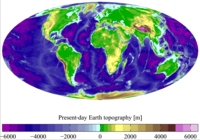Physical oceanography

Physical oceanography is the study of the physical properties of the ocean. Just like how we have a body with different parts like our head, legs, and arms, the ocean also has different parts like the surface, the deep ocean, and the bottom. Scientists who study physical oceanography want to understand how all these parts of the ocean work together.
One of the most important things scientists study in physical oceanography is the movement of water in the ocean. The water in the ocean is constantly moving and changing, just like how we move around and change direction when we play a game. The movement of water in the ocean is called ocean currents, and scientists try to understand why they move and where they go.
Another important thing scientists study is waves. Waves are like big bumps in the ocean that move up and down, and they can be caused by things like wind, tides, and earthquakes. Scientists want to understand why waves happen and how they can affect things like ships and coastlines.
Scientists in physical oceanography also study things like temperature and saltiness in the ocean. Just like how we have a thermometer to measure the temperature, scientists have special tools to measure the temperature and saltiness of the ocean. Understanding these things is important because different fish and other animals need different temperature and salt levels to survive.
Physical oceanography is really important because the ocean is a huge part of our planet, and it affects things like weather, climate, and even the economy. Scientists in physical oceanography work hard to learn more about the ocean and how it works so we can better understand and take care of our planet.
One of the most important things scientists study in physical oceanography is the movement of water in the ocean. The water in the ocean is constantly moving and changing, just like how we move around and change direction when we play a game. The movement of water in the ocean is called ocean currents, and scientists try to understand why they move and where they go.
Another important thing scientists study is waves. Waves are like big bumps in the ocean that move up and down, and they can be caused by things like wind, tides, and earthquakes. Scientists want to understand why waves happen and how they can affect things like ships and coastlines.
Scientists in physical oceanography also study things like temperature and saltiness in the ocean. Just like how we have a thermometer to measure the temperature, scientists have special tools to measure the temperature and saltiness of the ocean. Understanding these things is important because different fish and other animals need different temperature and salt levels to survive.
Physical oceanography is really important because the ocean is a huge part of our planet, and it affects things like weather, climate, and even the economy. Scientists in physical oceanography work hard to learn more about the ocean and how it works so we can better understand and take care of our planet.
Related topics others have asked about:
